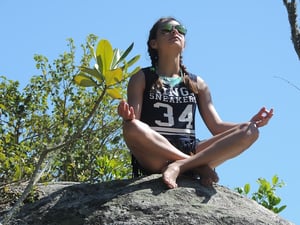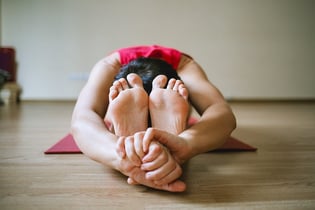Creating a Yoga Practice for Children With Autism
Yoga, an ancient practice that originated in India, is today a term familiar across most of the world. Those who’ve experienced the practice may be familiar with its benefits of relaxation and overall improved physical health. Did you know, however, that exploring yoga with a child with autism can help him or her improve mobility, spatial awareness, coping skills, and even contribute to self-confidence?
 Before thinking about your child first imagine:
Before thinking about your child first imagine:
How might your body and mind respond when surrounded by a peaceful space, where there is no rush and no competition, and the repetition of the movement allows you to learn poses in a relaxed manner, where you can breathe fully and deeply, and bring awareness into yourself? Hopefully part of this resonates with you, as I believe it will with your child.
Benefits of Yoga for Autism:
The benefits for children with autism who are involved in a consistent yoga practice are noteworthy as follows:
Motor Skills
Yoga is a practice that requires holding a wide variety of poses and stretches. With each pose children are learning skills that build balance and patience, and which manipulate and utilize the limbs, trunk, face - it’s a whole body experience! This practice brings muscle memory to your child’s body through repetitive and routine poses, and helps him or her develop motor skills each step along the way.
Coping Skills and Relaxation
Yoga, through movement and breathing, has a natural ability to relax the body. Through yoga children with autism can reduce activity in their sympathetic nervous system, the system which activates the adrenal glands and the fight or flight response. The poses and breathing actually activate the parasympathetic nervous system, which is responsible for slowing breathing, heart rate, and aiding digestion. And, building a repertoire of tools for relaxation can help an ASD child cope through other life challenges. Now that’s great news for your child and for all who do yoga!
This study “Effect of Yoga Intervention on Short-Term Heart Rate Variability in Children with Autism Spectrum Disorder”, though using a small sample size, demonstrates significant positive effects of yoga on the heart rates of children with autism.
Confidence in Individuality
Yoga promotes confidence by encouraging a child to move at his or her own speed, providing repetition and consistency, and allowing the child to celebrate mastery through his or her own practice and personal milestones. And, yoga allows for individualizing the environment so children with autism can practice in a comfortable space that meets their needs. It’s a special space for a child with autism to gain a sense of individuality, personal confidence, and accomplishment.
Body Awareness
 Children learn body awareness while interacting with their own bodies through each pose and breath and by observing their teachers and others alongside them. They can gauge how their limbs and body extend in relation to people and things around them. Once children are more aware of their own bodies and how they work, they gain more ability to control their bodily actions which promotes stronger self-regulation.
Children learn body awareness while interacting with their own bodies through each pose and breath and by observing their teachers and others alongside them. They can gauge how their limbs and body extend in relation to people and things around them. Once children are more aware of their own bodies and how they work, they gain more ability to control their bodily actions which promotes stronger self-regulation.
This article by MGH Aspire, “Beyond Breathing- The Benefits of Yoga on Children with ASD”, highlights and provides information on these and other positive benefits of yoga.
Setting Up Your Practice:
Materials:
Yoga is an activity that requires very few materials. All that’s needed is a space and a yoga mat (or mat that provides traction so feet don’t slip). A light blanket for cushion under the knees or during relaxation can also be helpful. Some practices use a strap for stretching poses.
*Note that some new yoga mats may have a strong smell bothersome to chemically sensitive children. Some eco-friendly yoga mats with fewer chemicals, or mats that have had considerable time to air out may be preferred. New mats can also be washed in a washing machine.
Environment:
Yoga can be practiced anywhere -inside, outside, at home, school or any other space that provides a comfortable and consistent environment.
Since yoga is a relaxing restorative practice, creating an environment that supports this is important. To the best of your ability, provide a calm space. If music is incorporated consider the pace and volume of the music. Since some yoga postures may have children staring at the ceiling, soft lighting that still allows the child to see the teacher and poses may help. Based on your child’s needs you can customize the environment to fit.
Who is Involved:
Yoga is an individualized practice that can be done in a group or on one’s own. For your child with ASD identify the resources available in your area. If your child’s school provides a yoga program, great! In this setting your child can practice yoga with classmates, but may still require individualized attention, particularly in the beginning. Or you may opt to find a yoga teacher in your area that has experience working with children with special needs and autism. Another great option is to do yoga with your child. Family yoga or yoga with a caregiver can provide wonderful quality time where everyone can benefit from a regular yoga routine.
Tips to Get Started:
- Remind yourself and your child that yoga is not a race but a personal practice. Provide repetition of postures and time for your child to complete poses at his or her pace.
- Children with ASD will need some assistance with the postures from a teacher or caregiver in the beginning. After initial practice and guidance they will be able to move into these postures with more confidence. Some studies on chidren with autism report great improvements in children’s ability to maintain postures, improve speech, eye contact, and the ability to imitate others as the yoga practice progresses.
- Provide a visual to your child of each posture. It can help children to watch a teacher or caregiver complete the pose along with them. Some practices use a visual plan with the order of postures next to their image that children can reference.
- Bring awareness to breathing. This study “Integrated approach to yoga therapy and autism spectrum disorders”, used mirrors, bubbles, and toys with children with ASD to help them learn deeper breathing techniques.
- Provide a consistent and frequent routine. Some school-based studies provided an hour of yoga daily or a few times a week-- find what works for you and your child, and stick with it!
Poses:
Many poses used in traditional yoga can be beneficial for ASD children. Below are two videos that address poses for children with Autism.
This ~10 minute video “Teaching Yoga to Children with Autism” provides yoga postures for children with ASD. A young ASD boy shares tips on his own yoga practice.
This ~12 minute video “Kids Adaptive Yoga” provides postures for an adaptive yoga practice for children with disabilities.
Additional Resources:
The National Center on Health, Physical Activity and Disability (NCHPAD) webpage provides a table of contents with information on yoga benefits, materials, teachers, etc.
The International Association of Yoga Therapists (IAYT) webpage provides information on yoga and therapists more broadly.
This article, “Efficacy of the Get Ready to Learn Yoga Program Among Children with Autism Spectrum Disorders: a Pretest- Posttest Control Group Design” looked at school-based manualized yoga programs and positive classroom behavioral changes for ASD children.
The “Get Ready to Learn” webpage discusses their school wide yoga programs.
Arielle Doochin
Arielle is a senior learning experience designer and writer who has created online, print, and blended educational materials for a diverse range of learners. Her academic background in the principles of education, neuroscience, and psychology informs her work in enhancing comprehension and promoting a sense of exploration in the design and facilitation of educational products.




